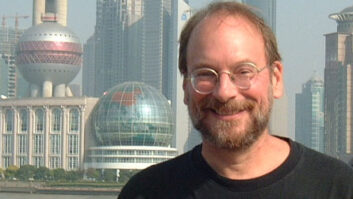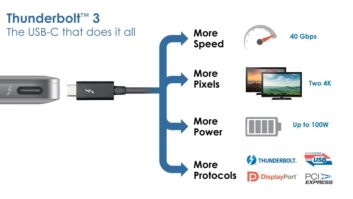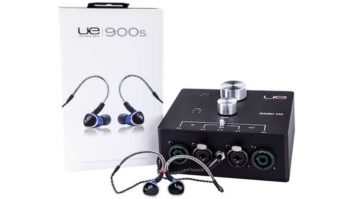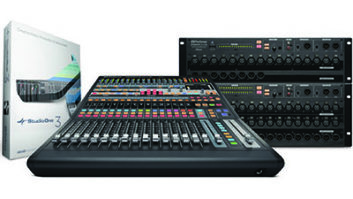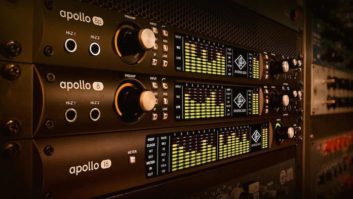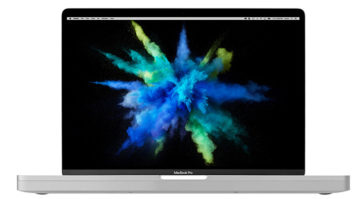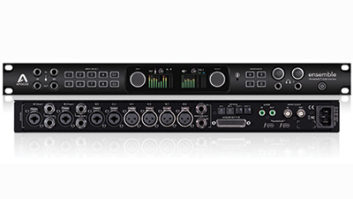MOVING TOWARD INTEROPERABILITYOnce upon a time, in my City By The Bay, where Green Street hits Telegraph Hill, there was a warehouse. On the second floor, a fellow named Philo T. Farnsworth built what was arguably the first all-electronic television system. (Sincere apologies to Vladimir Zworykin.) Thirty years later, the NTSC created what was, again arguably, the worst color television standard to survive until the present. We’ve been stuck with it for over 40 years, and, despite all its problems, it seamlessly delivers “content” to our homes. That will all change when, six years from now, we close the door on analog TV and, hopefully, feel no need to look back. Ha, I laugh at my own optimism!
I say hopefully, because, as I mentioned in past columns, our upcoming “advanced” TV system is not without its problems, ignoring the fact that, at least in the short term, the audio and video quality will be worse than what we have now; ignoring another fact that if you live in an urban canyon as I do, then you may have to buy cable, because there’s a good chance that over-the-air reception won’t work.
Right about this moment, you’re thinking, “Hey schmuck, this is an audio magazine!” What DTV and this month’s continuing saga have in common is the “i” word: interoperability, or lack thereof. Technology, pulled in diverse directions by special interests, makes for a chimera that can’t get up and walk out the door of your local consumer electronics retailer. Sorry to mix my metaphors, but, as I remind you all the time, it’s the consumer, stupid! Or rather, it’s the CE manufacturers and content holders that drive our audio industry. Like audio, as goes CE, so goes FireWire.
TOO MANY COOKS?There are several camps working on “standards” for 1394 protocols. Several is, in my opinion, too many. For one, there’s HAVi, an industry consortium trying to steer 1394 applications in the CE space. For another, there’s Yamaha proposing its mLAN protocol as the specification for “Audio and Music Data Transmission” to the 1394 Trade Association’s AV Working Group. Strange that Sony, an early adopter of FireWire, hasn’t used it yet on any audio gear…
The David among all these Goliaths is Digital Harmony (www. digitalharmony.com), a provider of tools, chip designs, software and product certification services. DH has come up with a bunch of stuff to address many of the issues facing a company wanting to mesh FireWire and audio. With a growing number of licensees, including Harman/Kardon, Lexicon, Madrigal Audio Labs, JBL, Infinity, Meridian Audio Group, Denon, Onkyo, Boston Acoustics, Panja and Sensory Science Corporation, as well as semiconductor partners Cirrus Logic, Crystal Semiconductors and ARM, Digital Harmony has a good deal of industry support. Right after the 1394 DevCon, I talked to the head honcho, Bob Moses, about his company. Their dream of all data formats – multichannel and Red Book audio, MIDI, raw data files, even video – being transferred over the 1394 bus without burdening the user with complicated format transcoding and synchronization decisions may come to pass.
Moses is excited about the prospects of using FireWire in studios but also foresees potential problems. “1394’s job really ends after you’ve moved a giant block of data from one device to another,” he says. “It defines the basic data transport services in a system, but… not which audio and video formats or optional bus management services should be supported or how the equipment is controlled. This is left to developers to define, according to the intended application and require- ments of their products.” There, my friend, is the rub. With such a wide-ranging standard, capable of handling isochronous data like audio, video and MIDI that requires guaranteed latency, as well as asynchronous data like IP, SCSI and other computer babel, there’s bound to be some confusion and duplication when vendors get around to implementing this stuff at the application level.
Try this FireWire test for yourself; it requires that you have a DAW and that the CPU has a 1394 spigot. (That, in itself, is a bit of a trick in many cases as Intel has steadfastly refused to support 1394: They’ve got USB, dammit, and that’s the end of the argument.) Ask the DAW manufacturer whether, for the recording of audio data, it supports Micronet’s SANcube or any other 1394-attached storage. The answer most likely will be, “Real soon now.” It seems that most folks I’ve talked to can’t get the disks they’ve tested to behave consistently. Drivers could be to blame, but no one will fess up.
Then there’s the jitter issue. As FireWire is a packet-switched bus, there’s no synchronous clock carried along to convey timing. And there are a myriad of sources of jitter within the 1394 transport protocol, the main source being that you have a free-running oscillator in every node on the bus. Says design consultant and engineer Julian Dunn, “The IEEE 1394 format uses asynchronous clocks at each node. The interaction of these clocks with each other and with the sample (word) clock generates jitter.” Given that, Digital Harmony has devised many tricks to bring the aggregate jitter down to something reasonable, like changing the nature of the jitter so psychoacoustically, the result is less annoying. Bob Moses says that Digital Harmony’s new silicon should deliver something in the “100 picosecond range.” They’ve even managed to “hide” house sync on the bus. (By the way, Bob founded Wadia Digital, considered by many to make super-sweet converters. So, he’s no tin ear.)
WORKING TOWARD COMPATIBILITY”For pro audio applications, you don’t have a protocol stack that goes all the way into the application layer yet, and so each company is looking at different ways of solving this; and we could have a real interoperability problem if we’re not careful,” says Bob Moses. “There’s a lot of companies that want to be first to the street with new equipment, so they’d have bragging rights…The industry needs to pull together on this; otherwise, we’re going to wind up with the same problem as with our computers.” That is, poor compatibility at great cost in wasted time and frustration. That’s where Digital Harmony comes in, trying to come up with a system and implementation guidelines so manufacturers can collaboratively ensure that all the boxes that have that plug on them work together. They’re not the only ones worrying about this. Roger Siminoff, one of Apple’s senior marketing managers, echoed the same sentiment. “We are committed to the best user experience for creative professionals, so they spend their valuable time creating instead of troubleshooting,” he says. “Working toward one connector for storage, audio and MIDI can contribute to that commitment.”
According to figures predicted by industry maven Cahners, 200 million 1394-equipped products will have shipped by 2003. Sony’s recent smash hit, Playstation II, has the dynamic duo of 1394 and DVD; it should ship more than 20 million of the little beasties by the end of next year. Though it isn’t perfect, 1394 is here for the long haul, and as Bob Moses says, “It gets us 90 percent of the way to a universal standard” for media production and dissemination. Just keep your fingers crossed.
HAVi is the Home Audio Video Interoperability collective. They’re your basic monster CE vendors trying to reach consensus: Grundig, Matsushita, Philips, Sharp, Sony and Thomson, along with Hitachi and Toshiba providing chip-level support. HAVi states, “most HAVi-compliant devices will come with their own dynamic Device Control Modules. Updating functionality can be done by downloading/uploading new capabilities via the Internet” through any device on the bus with an Internet connection. Next year, progressive CE manufacturers like Samsung will have 1394-enabled DTV tuners, integrated HDTV sets and other set top-boxes designed for use with displays.
Think that DVD-A’s a nonstarter? You may be right, unless the CE manufacturers get their act together with maxi-players that handle DVD-A, V and R, as well as SACD. Many brains in the audio community are wondering why all currently shipping DVD-A and SACD players only have analog outputs. Relying on those manufacturers to get the critical digital-to-analog conversion right is not a comforting concept. The reason, though, is clear, and it’s called Copy Protection. Though other methods have been proposed to move A/V data from one CE device to another, 1394 seems to be the logical choice. Now that the 5C standard is in place, manufacturers will be unshackled by the big content holders to start getting out the DVD-A product. However, the low cost, high speed and ease of configuration must be balanced against licensing, latency and those jitter issues that could upset the rapid adoption of this technology.
